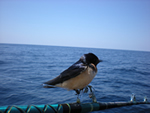| Spring
2010 |
| |
 |
Signs
of Spring: Observation Reminder for May
From barn swallows to BioBlitz, we have a lot
to celebrate this month. Alaska reports their first mosquito
sightings. Warblers, hummingbirds, and grosbeaks are making
their way north. Did you know barn swallows migrate 4,000
miles and more each spring and fall? Investigate a BioBlitz
and consider having one at your school. Photo:
David Hutchinson |
 |
Signs
of Spring: Observation Reminder for April
April brings the great greening. Nature's timing is perfect.
Leaves emerge, insects hatch and birds arrive. The food chain
comes alive after the pause for winter. Listen for new sounds,
and observe the small changes that happen every day now. Fill
in the maps with your sighting reports. Create a record of
leaf out. Put it into a book you can keep and compare with
each coming year. |
 |
Signs
of Spring: Observations for March
March
is a time of dramatic change. Make a temperature timeline
this month. Record each day's high, low, and average temperatures
and add all the signs of spring you notice. Spring officially
begins on March 20, but when does it begin unofficially
for you? Think about it. Send us your sightings. Keep your
eyes and ears open and follow along on spring's adventures
with Journey North! |
 |
Signs
of Spring: Observation Reminder for February
Are YOU ready to track spring's journey north? Thousands of
students are watching and waiting for the migrations to begin.
Keep your eyes and ears open and follow along on spring's
adventures with Journey North! Send us your sightings. Watch
a hibernating momma with her new born cub through a web camera
at the North American Bear Center. Photo:
Dave Mansell |
 |
Signs
of Spring: Observation Reminder for January
This month we focus on water. How does it change in the cold
and what makes it unique. The view from space tells a story
about sunlight and we begin to see a pattern from fall to
winter. What will happen in one month? Amazing things happen
with each season. What do insects do when winter comes? Find
out in this update! Photo:
©2007 Tom Henthorn Sr. |
| Fall
2009 |
 |
Signs
of Fall: Observations for December
The Winter Solstice arrives in December. Mark your calendars
for the 21st! Draw a picture showing where the sun is in the
sky at noon that day. You and your global partner can compare.
How has the sunlight and shadow changed since last month?
How do huge flocks of birds keep from bumping into each other
in flight? Amazing things happen with each season.
Photo: PBS.org |
 |
Signs
of Fall: Observations for November
How are the changing seasons affecting YOU? Take a minute
and think of the ways. Study the Earth viewed from the moon.
How has the sunlight and shadow changed since last month?
Amazing things happen with each season. Learn about the millions
of butterflies that observers reported in October. Why do
you think they call this butterfly a snout? |
 |
Signs
of Fall: Observations for October
What kinds of changes have you noticed since a month ago?
Once each month, take a few minutes to go outside and record
the changes you see. What is the biggest change? Learn what
northern birds are migrating through the Great Lakes at Duluth.
Then take a box of colors outside and make some art using
the colors you see in nature. What is your batting average;
learn about the amazing mammal called the bat.
Photo: Debbie Waters |
 |
Signs
of Fall: Observations for September
What does fall look like in your part of the world? Once each
month, take a few minutes to go outside and record the changes
you see. Plan to go outside exactly one month later and see
how things have changed. Watch for a monthly reminder. Keep
in mind that shifting sunlight is the basis for all other
changes you'll see this season!
Photo: Laura Erickson |
 |
Join
us in September!
SIGNS OF FALL OBSERVATION REMINDERS will
be posted here once a month from September through June.
Get
ready to gather data about fall changes! Find out why it's
worth collecting, how to do it, and what you can do with
your findings. >>
Photo:
Suzanne DeJohn
|